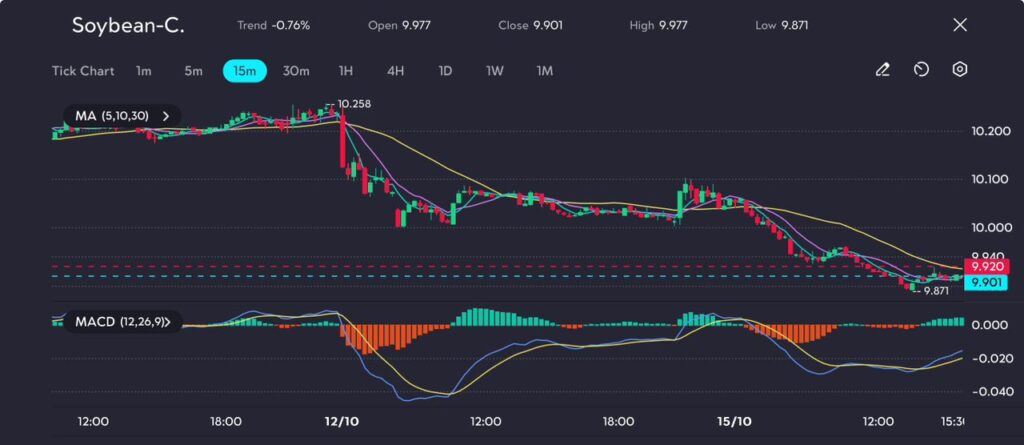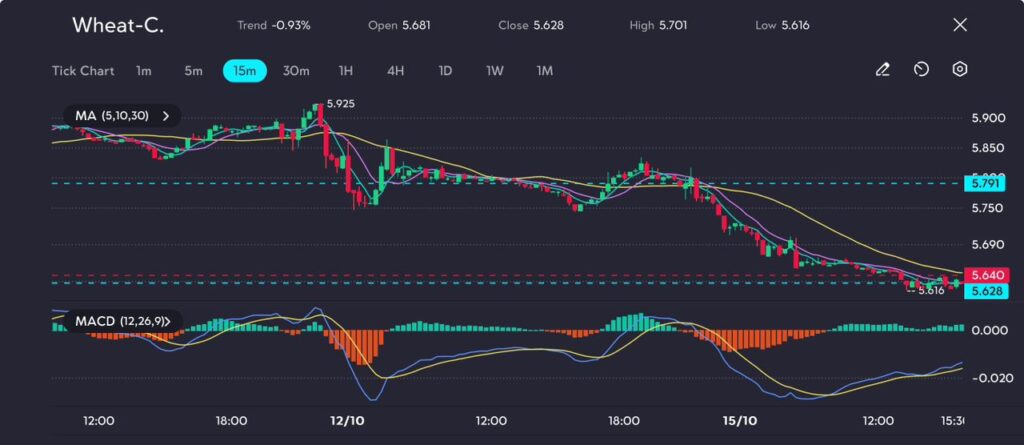Key Points:
- Soybeans fell 1% to $9.86 a bushel, pressured by record U.S. output.
- Wheat dropped 1.1% to $5.78-3/4 as USDA raised stock estimates.
- Brazil’s forecast rains improve soybean planting prospects.
- A stronger U.S. dollar weighs on global trade competitiveness.
Soybean futures dipped for a fourth consecutive session on Tuesday, down 1% to $9.86 a bushel.
The market remains pressured by the largest U.S. soybean crop on record, with the USDA slightly revising production estimates lower but confirming strong output.
Further weighing on soybean prices are improved weather forecasts in Brazil, where expected rains are likely to break a prolonged dry spell.
As of last Thursday, only 8.2% of Brazil’s soybean area had been planted, compared to 17% during the same period last year.
With the incoming rains, planting activity is expected to pick up, adding downward pressure to global soybean prices.
Soybean-C Technical Analysis

Picture: Soybean futures drop to 9.901, weighed down by bearish momentum, as seen on the VT Markets app.
From the soybean futures chart, we see a close at 9.901, reflecting a 0.76% decline during the session.
The price dropped from a high of 10.258 to a low of 9.871, indicating bearish momentum. The moving averages (5, 10, and 30-period) are trending downward, confirming the continued pressure on prices.
The MACD line remains below the signal line, with negative histogram bars growing, suggesting persistent selling pressure.
Recent news reveals that soybean prices have been under pressure due to ample global supply, with Brazil expected to produce another record crop of 169 million metric tons.
Demand from China has shifted more toward Brazilian soybeans, reducing U.S. exports, further weighing on prices.
The harvest season is also underway, and seasonal trends suggest soybean prices tend to bottom out in October before stabilising later in the year.
Wheat Slips as USDA Raises Global Stock Estimates

Picture: Wheat futures decline to 5.628, with selling pressure building amidst ample global harvest forecasts and intensified competition, as seen on the VT Markets app.
Wheat futures closed at 5.628, declining by 0.93% for the session. The price hit a session low of 5.616 from a high of 5.701, reinforcing the downward trend.
The chart reflects bearish alignment in the moving averages, with prices consistently below the 30-period average.
The MACD shows the MACD line well below the signal line, with negative histogram bars increasing, indicating that selling momentum is intensifying.
While these higher stock estimates weighed on prices, traders remain focused on disruptions in supply from the Black Sea region.
See also: Wheat Rises as Dry Weather Impacts Global Crops
Russia has set higher export duties and price thresholds for wheat shipments, but these measures have not been as restrictive as initially feared.
Weather and Geopolitical Risks Create Mixed Outlook for Wheat
Wheat production remains under pressure in Argentina and Australia, where dry conditions have reduced yields.
Argentina recently received some rain over the weekend, providing minor relief, though uncertainties persist.
Wheat prices have stayed relatively stable compared to corn and soybeans, which have seen steeper declines.
Stronger U.S. Dollar Impacts Global Trade Dynamics
Both soybean and wheat futures are feeling the impact of a stronger U.S. dollar.
The rising dollar index makes U.S. exports more expensive for international buyers, complicating trade flows and adding further downside risk to prices.
As the United States is a leading exporter of both crops, currency trends will continue to play a crucial role in determining market direction.
Looking ahead, market participants will monitor South American weather patterns and Black Sea developments closely.
Any delays in Brazilian planting or geopolitical shifts in the Black Sea region could affect supply outlooks, potentially stabilising prices in the coming weeks.
Start trading now — click here to create your live VT Markets account.









